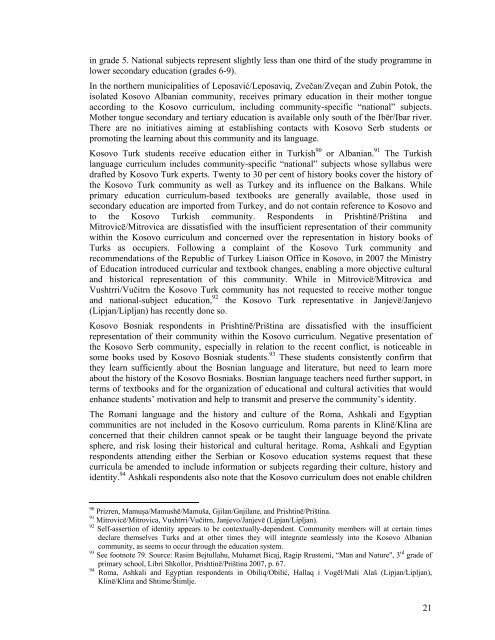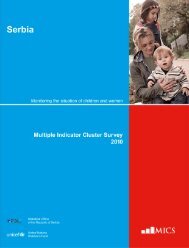Kosovo non-majority communities within the primary and ... - OSCE
Kosovo non-majority communities within the primary and ... - OSCE
Kosovo non-majority communities within the primary and ... - OSCE
You also want an ePaper? Increase the reach of your titles
YUMPU automatically turns print PDFs into web optimized ePapers that Google loves.
in grade 5. National subjects represent slightly less than one third of <strong>the</strong> study programme inlower secondary education (grades 6-9).In <strong>the</strong> nor<strong>the</strong>rn municipalities of Leposavić/Leposaviq, Zvečan/Zveçan <strong>and</strong> Zubin Potok, <strong>the</strong>isolated <strong>Kosovo</strong> Albanian community, receives <strong>primary</strong> education in <strong>the</strong>ir mo<strong>the</strong>r tongueaccording to <strong>the</strong> <strong>Kosovo</strong> curriculum, including community-specific “national” subjects.Mo<strong>the</strong>r tongue secondary <strong>and</strong> tertiary education is available only south of <strong>the</strong> Ibër/Ibar river.There are no initiatives aiming at establishing contacts with <strong>Kosovo</strong> Serb students orpromoting <strong>the</strong> learning about this community <strong>and</strong> its language.<strong>Kosovo</strong> Turk students receive education ei<strong>the</strong>r in Turkish 90 or Albanian. 91 The Turkishlanguage curriculum includes community-specific “national” subjects whose syllabus weredrafted by <strong>Kosovo</strong> Turk experts. Twenty to 30 per cent of history books cover <strong>the</strong> history of<strong>the</strong> <strong>Kosovo</strong> Turk community as well as Turkey <strong>and</strong> its influence on <strong>the</strong> Balkans. While<strong>primary</strong> education curriculum-based textbooks are generally available, those used insecondary education are imported from Turkey, <strong>and</strong> do not contain reference to <strong>Kosovo</strong> <strong>and</strong>to <strong>the</strong> <strong>Kosovo</strong> Turkish community. Respondents in Prishtinë/Priština <strong>and</strong>Mitrovicë/Mitrovica are dissatisfied with <strong>the</strong> insufficient representation of <strong>the</strong>ir community<strong>within</strong> <strong>the</strong> <strong>Kosovo</strong> curriculum <strong>and</strong> concerned over <strong>the</strong> representation in history books ofTurks as occupiers. Following a complaint of <strong>the</strong> <strong>Kosovo</strong> Turk community <strong>and</strong>recommendations of <strong>the</strong> Republic of Turkey Liaison Office in <strong>Kosovo</strong>, in 2007 <strong>the</strong> Ministryof Education introduced curricular <strong>and</strong> textbook changes, enabling a more objective cultural<strong>and</strong> historical representation of this community. While in Mitrovicë/Mitrovica <strong>and</strong>Vushtrri/Vučitrn <strong>the</strong> <strong>Kosovo</strong> Turk community has not requested to receive mo<strong>the</strong>r tongue<strong>and</strong> national-subject education, 92 <strong>the</strong> <strong>Kosovo</strong> Turk representative in Janjevë/Janjevo(Lipjan/Lipljan) has recently done so.<strong>Kosovo</strong> Bosniak respondents in Prishtinë/Priština are dissatisfied with <strong>the</strong> insufficientrepresentation of <strong>the</strong>ir community <strong>within</strong> <strong>the</strong> <strong>Kosovo</strong> curriculum. Negative presentation of<strong>the</strong> <strong>Kosovo</strong> Serb community, especially in relation to <strong>the</strong> recent conflict, is noticeable insome books used by <strong>Kosovo</strong> Bosniak students. 93 These students consistently confirm that<strong>the</strong>y learn sufficiently about <strong>the</strong> Bosnian language <strong>and</strong> literature, but need to learn moreabout <strong>the</strong> history of <strong>the</strong> <strong>Kosovo</strong> Bosniaks. Bosnian language teachers need fur<strong>the</strong>r support, interms of textbooks <strong>and</strong> for <strong>the</strong> organization of educational <strong>and</strong> cultural activities that wouldenhance students’ motivation <strong>and</strong> help to transmit <strong>and</strong> preserve <strong>the</strong> community’s identity.The Romani language <strong>and</strong> <strong>the</strong> history <strong>and</strong> culture of <strong>the</strong> Roma, Ashkali <strong>and</strong> Egyptian<strong>communities</strong> are not included in <strong>the</strong> <strong>Kosovo</strong> curriculum. Roma parents in Klinë/Klina areconcerned that <strong>the</strong>ir children cannot speak or be taught <strong>the</strong>ir language beyond <strong>the</strong> privatesphere, <strong>and</strong> risk losing <strong>the</strong>ir historical <strong>and</strong> cultural heritage. Roma, Ashkali <strong>and</strong> Egyptianrespondents attending ei<strong>the</strong>r <strong>the</strong> Serbian or <strong>Kosovo</strong> education systems request that <strong>the</strong>securricula be amended to include information or subjects regarding <strong>the</strong>ir culture, history <strong>and</strong>identity. 94 Ashkali respondents also note that <strong>the</strong> <strong>Kosovo</strong> curriculum does not enable children90 Prizren, Mamuşa/Mamushë/Mamuša, Gjilan/Gnjilane, <strong>and</strong> Prishtinë/Priština.91 Mitrovicë/Mitrovica, Vushtrri/Vučitrn, Janjevo/Janjevë (Lipjan/Lipljan).92 Self-assertion of identity appears to be contextually-dependent. Community members will at certain timesdeclare <strong>the</strong>mselves Turks <strong>and</strong> at o<strong>the</strong>r times <strong>the</strong>y will integrate seamlessly into <strong>the</strong> <strong>Kosovo</strong> Albaniancommunity, as seems to occur through <strong>the</strong> education system.93 See footnote 79. Source: Rasim Bejtullahu, Muhamet Bicaj, Ragip Rrustemi, “Man <strong>and</strong> Nature", 3 rd grade of<strong>primary</strong> school, Libri Shkollor, Prishtinë/Priština 2007, p. 67.94 Roma, Ashkali <strong>and</strong> Egyptian respondents in Obiliq/Obilić, Hallaq i Vogël/Mali Alaš (Lipjan/Lipljan),Klinë/Klina <strong>and</strong> Shtime/Štimlje.21
















